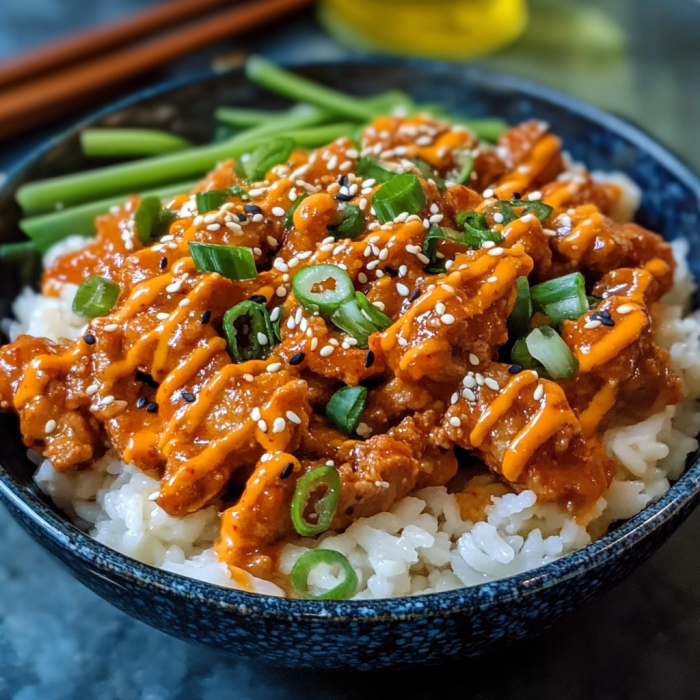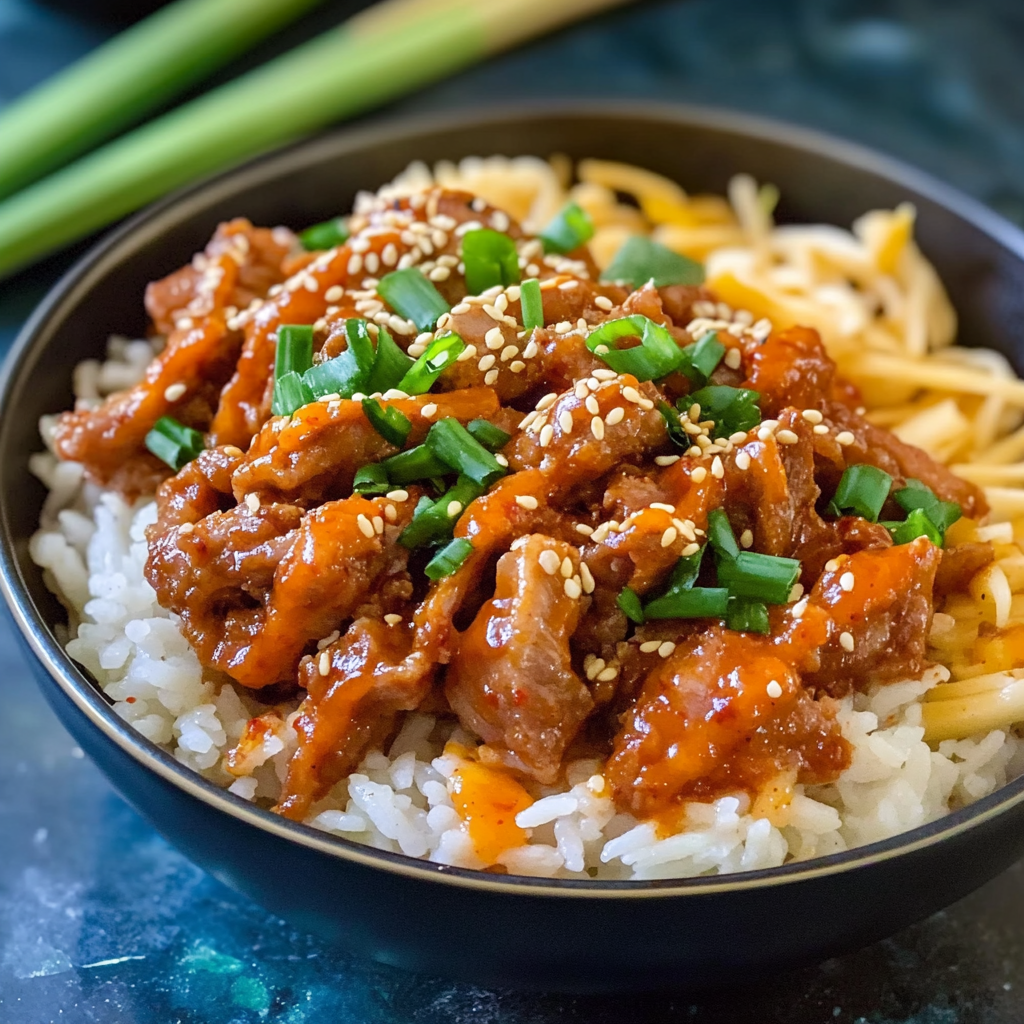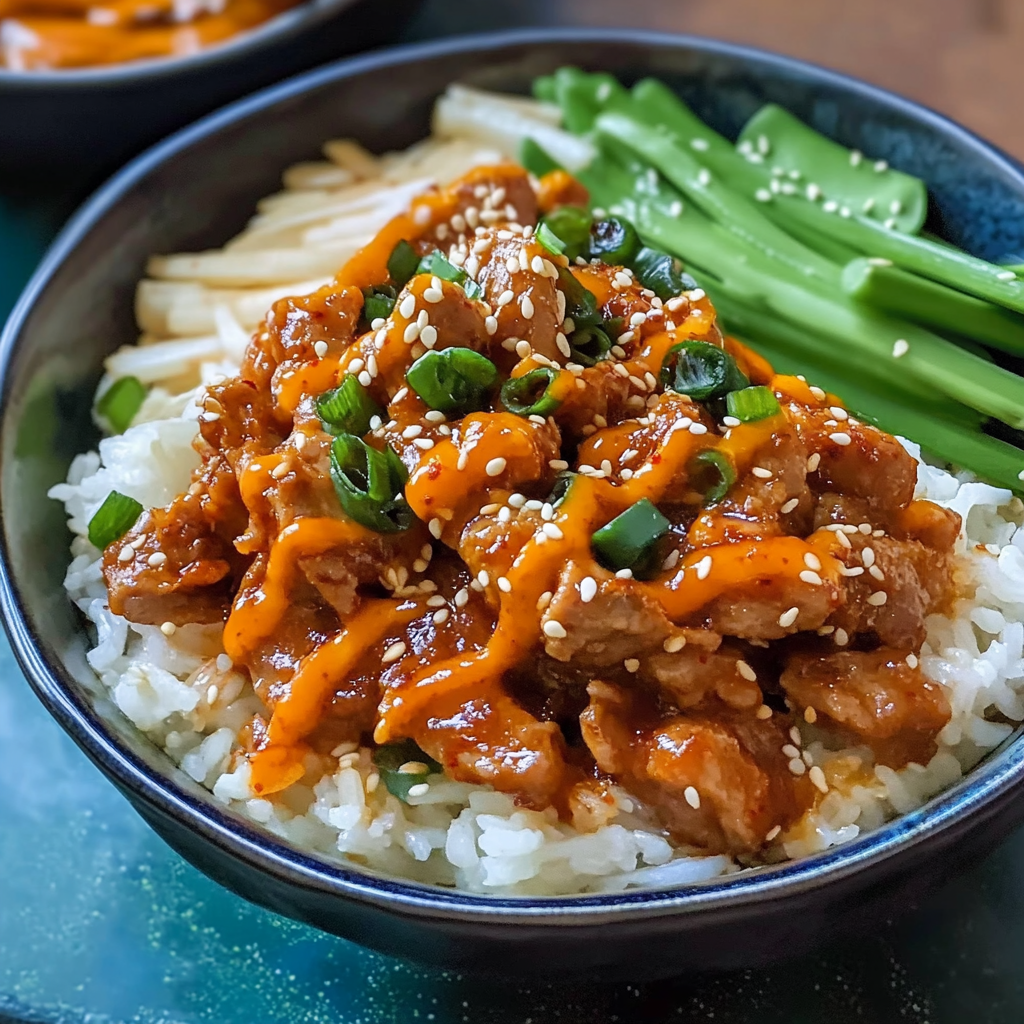I fell in love with Korean food during college when my roommate’s mom would send us back to school with containers of homemade kimchi and various banchan (side dishes). But it was her spicy pork that completely won me over. After YEARS of begging for the recipe and countless attempts to recreate it, I finally got pretty darn close with this version. Now it’s my go-to dinner when I’m craving something with a serious flavor kick!
These Korean Spicy Pork Bowls bring together tender, caramelized pork with a sweet-spicy-umami sauce that will make your taste buds do a happy dance. Served over rice with fresh vegetables and a runny egg on top? Pure heaven in a bowl! The best part? It comes together faster than delivery would take to arrive.
The Ingredients You’ll Need
For the Spicy Pork:
- 1½ pounds pork shoulder or pork belly, thinly sliced (you can ask your butcher to do this, or partially freeze it to make slicing easier)
- 5 cloves garlic, minced (yes, that much!)
- 1 tablespoon fresh ginger, grated
- ½ medium onion, grated (the secret texture booster!)
- 5 tablespoons gochujang (Korean red pepper paste – don’t substitute if you can help it!)
- 3 tablespoons brown sugar (or more if you like it sweeter)
- 2 tablespoons soy sauce
- 1 tablespoon sesame oil
- 2 tablespoons rice vinegar
- 1 tablespoon gochugaru (Korean red pepper flakes) – adjust to your heat preference
- 2 tablespoons apple or Asian pear, grated (the natural tenderizer!)
- 2 green onions, chopped
- 1 tablespoon neutral oil for cooking (like vegetable or canola)
For the Bowls:
- 4 cups cooked white rice (short grain works best, but use what you have)
- 1 English cucumber, thinly sliced
- 2 carrots, julienned or cut into thin matchsticks
- 1 cup kimchi (store-bought is fine, but homemade is amazing if you have it)
- 4 eggs (for frying)
- Sesame seeds for garnish
- Extra sliced green onions for garnish
- Sesame oil for drizzling
Let’s Make It Happen!
Marinating the Pork (The Most Important Part!)
- First things first – if your pork isn’t already sliced, pop it in the freezer for about 30 minutes to firm up. This makes it WAY easier to slice thinly. Then cut it into strips about ¼-inch thick and 2 inches long.
- In a large bowl, combine the garlic, ginger, grated onion, gochujang, brown sugar, soy sauce, sesame oil, rice vinegar, gochugaru, and grated apple/pear. Mix it all together until you’ve got a thick, reddish-brown paste. This marinade is the SOUL of the dish!
- Toss your sliced pork into the marinade and mix thoroughly with your hands (wear gloves if you don’t want spicy red hands!) until every piece is well coated. The grated onion and apple help tenderize the meat – it’s not just for flavor!
- Cover and let this marinate in the fridge for at least 30 minutes, but honestly? Overnight is when the magic REALLY happens. I often prep this before work in the morning for a super quick dinner that night.
Cooking the Pork
- When you’re ready to cook, take the pork out of the fridge about 20 minutes before cooking to take the chill off.
- Heat a large skillet or wok over medium-high heat until it’s nice and hot. Add the tablespoon of oil and swirl to coat.
- Add the marinated pork to the pan, but DON’T dump all the extra marinade in yet. You want to hear that satisfying sizzle as the meat hits the pan.
- Let the pork cook, stirring occasionally (not constantly!), so it gets those beautiful caramelized edges. This takes about 5-7 minutes depending on how thin you sliced it.
- Once the pork is nearly cooked through, pour in any remaining marinade and cook for another 1-2 minutes until the sauce thickens and gets all glossy and sticky. Add your chopped green onions in the last minute of cooking.
Assembling Your Bowls
- While the pork is cooking (or before if you’re not a multitasker), fry your eggs sunny-side up in a non-stick pan. I like the yolks runny so they create a sauce when broken over the rice, but cook them however you prefer!
- Time to build your bowls! Start with a good scoop of rice on the bottom. Pile some of that gorgeous spicy pork to one side.
- Arrange your cucumber slices, carrot matchsticks, and kimchi around the other sides of the bowl. It’s not just for looks – each bite should have different textures and temperatures!
- Gently place a fried egg on top, sprinkle with sesame seeds and extra green onions, and finish with a light drizzle of sesame oil.
The Art of Eating a Korean Bowl
There’s a technique to eating these bowls that maximizes flavor: Break that beautiful egg yolk and let it run down over everything. Then take your chopsticks (or fork, no judgment) and mix everything up a bit as you go. Each bite should have a combination of textures and flavors – the spicy-sweet pork, cooling vegetables, tangy kimchi, and creamy egg yolk all working together.
Make It Your Own
Over the years, I’ve played around with this recipe a LOT. Here are some of my favorite variations:
Veggie Additions:
- Blanched spinach tossed with a bit of sesame oil and salt
- Quick-pickled radishes (just soak them in rice vinegar with a pinch of sugar for 30 minutes)
- Sautéed mushrooms with a splash of soy sauce
- Bean sprouts tossed with sesame oil and salt
Protein Switch-ups:
- Chicken thighs work amazingly well here too (bonus: they’re cheaper!)
- Firm tofu, pressed and cubed, makes a great vegetarian option
- Ground pork saves you the slicing step and tastes super good
Heat Levels:
- For milder palates, reduce the gochujang to 3 tablespoons and skip the gochugaru
- For fire-breathers, add a minced Thai chili to the marinade
Dietary Adjustments:
- For gluten-free, use tamari instead of soy sauce (and check your gochujang – some brands contain wheat)
- For less sugar, halve the brown sugar and add a packet of monk fruit sweetener
Quick Tips From My Kitchen Disasters
- DON’T overcrowd your pan when cooking the pork. If needed, cook in batches. Overcrowding = steaming instead of caramelizing, and we want those delicious crusty edges!
- The pork continues cooking a bit after you take it off the heat, so don’t overdo it or it’ll get tough.
- If your sauce isn’t thickening, mix 1 teaspoon of cornstarch with 1 tablespoon of water and stir it in during the last minute of cooking.
- Made too much? The cooked pork freezes surprisingly well! I portion it out without the rice for quick lunches.
- If you can’t find gochujang, you’re really missing out on the authentic flavor, but in a pinch, you can mix 2 tablespoons red pepper flakes, 2 tablespoons miso paste, and 1 tablespoon honey. It’s not the same, but it’ll do in an emergency craving situation!
Prep-Ahead Game Plan
I’m all about working smarter, not harder in the kitchen. Here’s how to break this down for easy meal prep:
- The pork can be marinated up to 24 hours ahead (and it gets better!)
- Rice can be cooked ahead and reheated
- Veggies can be sliced and stored in water in the fridge the day before
- The entire dish (minus the egg) reheats beautifully for lunch the next day
Why This Recipe Works
The first time I made this for friends, my buddy Mike literally licked his bowl clean. It’s that good! The key is balancing all those flavors:
- The gochujang brings spicy, sweet, and umami notes all at once
- The brown sugar helps create those caramelized edges on the pork
- The acid from the rice vinegar cuts through the richness
- The grated apple tenderizes the meat while adding subtle sweetness
- The egg yolk creates a rich sauce that brings everything together
I’ve served this to picky eaters, adventurous foodies, and even my Korean-American friend who gave it her stamp of approval (after suggesting a bit more gochugaru, which I’ve incorporated into this recipe).
This is one of those recipes that looks impressive but is actually pretty simple once you have the ingredients. It’s become my go-to for dinner parties when I want to seem fancy without stressing myself out!
Give it a try, and I promise it’ll enter your regular rotation. Just be prepared for the requests to make it again and again!
PrintKorean Spicy Pork Bowls (Dweji Bulgogi)
Description
I fell in love with Korean food during college when my roommate’s mom would send us back to school with containers of homemade kimchi and various banchan (side dishes). But it was her spicy pork that completely won me over. After YEARS of begging for the recipe and countless attempts to recreate it, I finally got pretty darn close with this version. Now it’s my go-to dinner when I’m craving something with a serious flavor kick!
These Korean Spicy Pork Bowls bring together tender, caramelized pork with a sweet-spicy-umami sauce that will make your taste buds do a happy dance. Served over rice with fresh vegetables and a runny egg on top? Pure heaven in a bowl! The best part? It comes together faster than delivery would take to arrive.
Ingredients
For the Spicy Pork:
- 1½ pounds pork shoulder or pork belly, thinly sliced (you can ask your butcher to do this, or partially freeze it to make slicing easier)
- 5 cloves garlic, minced (yes, that much!)
- 1 tablespoon fresh ginger, grated
- ½ medium onion, grated (the secret texture booster!)
- 5 tablespoons gochujang (Korean red pepper paste – don’t substitute if you can help it!)
- 3 tablespoons brown sugar (or more if you like it sweeter)
- 2 tablespoons soy sauce
- 1 tablespoon sesame oil
- 2 tablespoons rice vinegar
- 1 tablespoon gochugaru (Korean red pepper flakes) – adjust to your heat preference
- 2 tablespoons apple or Asian pear, grated (the natural tenderizer!)
- 2 green onions, chopped
- 1 tablespoon neutral oil for cooking (like vegetable or canola)
For the Bowls:
- 4 cups cooked white rice (short grain works best, but use what you have)
- 1 English cucumber, thinly sliced
- 2 carrots, julienned or cut into thin matchsticks
- 1 cup kimchi (store-bought is fine, but homemade is amazing if you have it)
- 4 eggs (for frying)
- Sesame seeds for garnish
- Extra sliced green onions for garnish
- Sesame oil for drizzling



